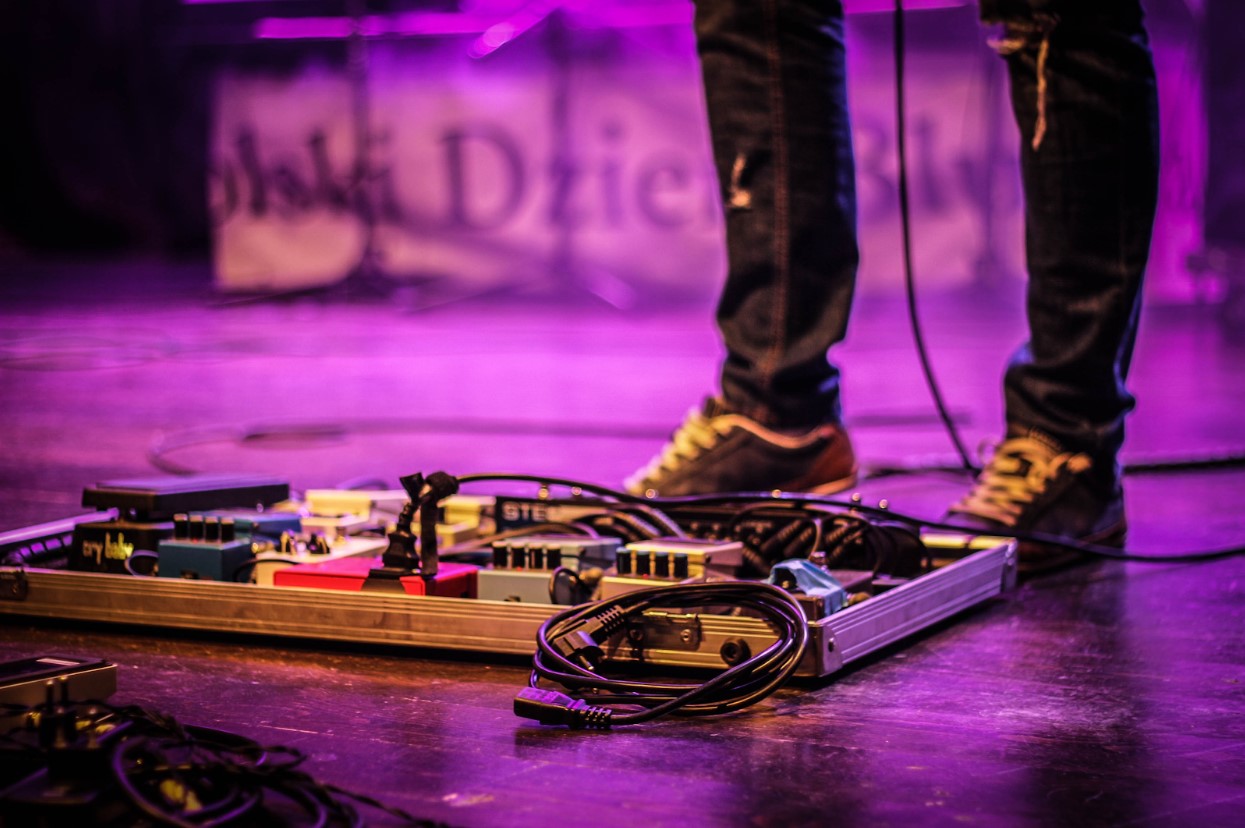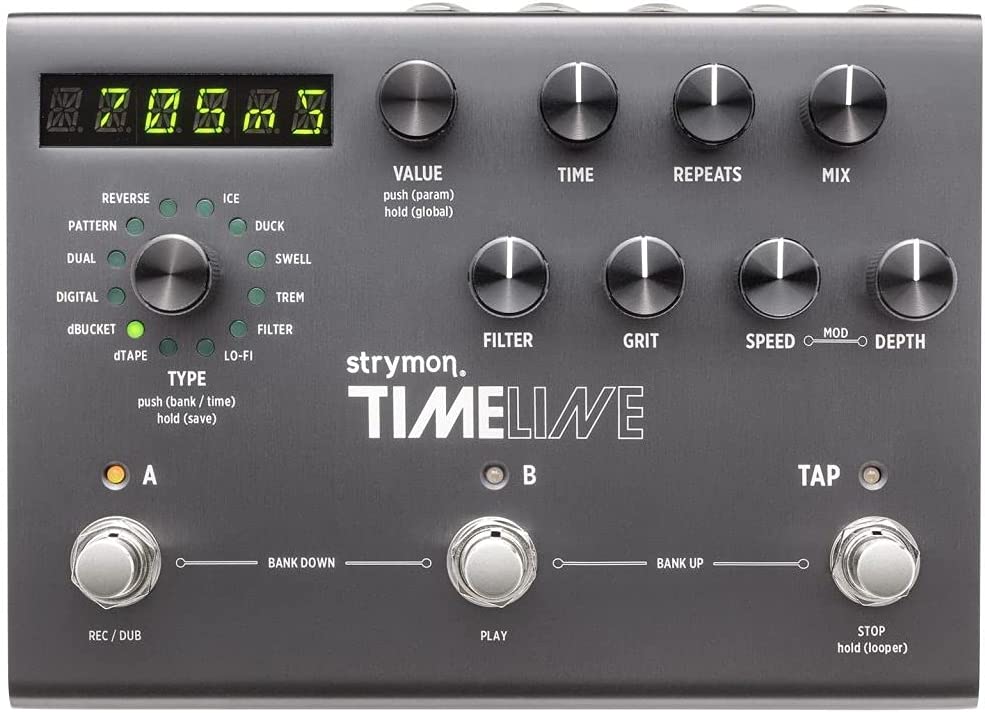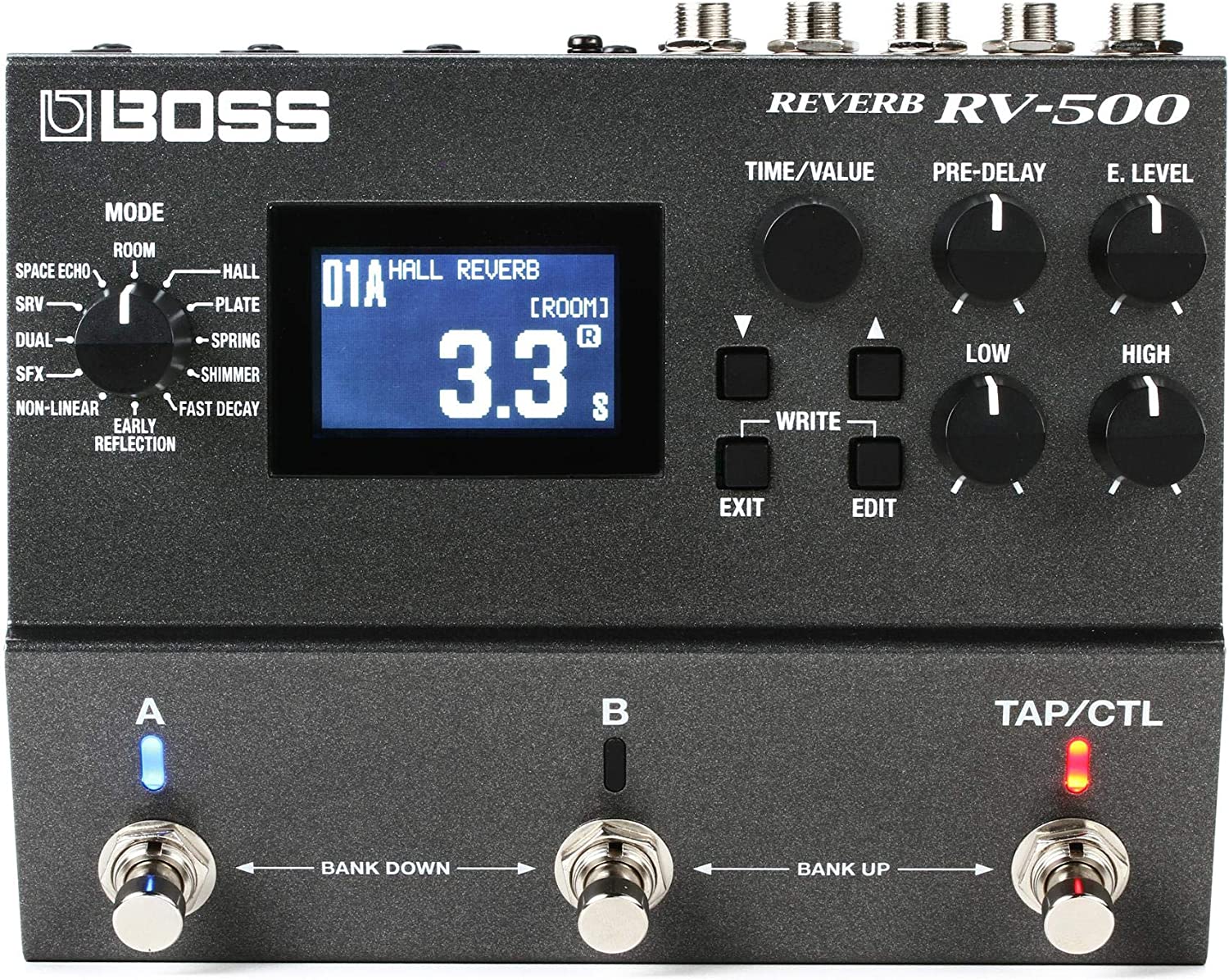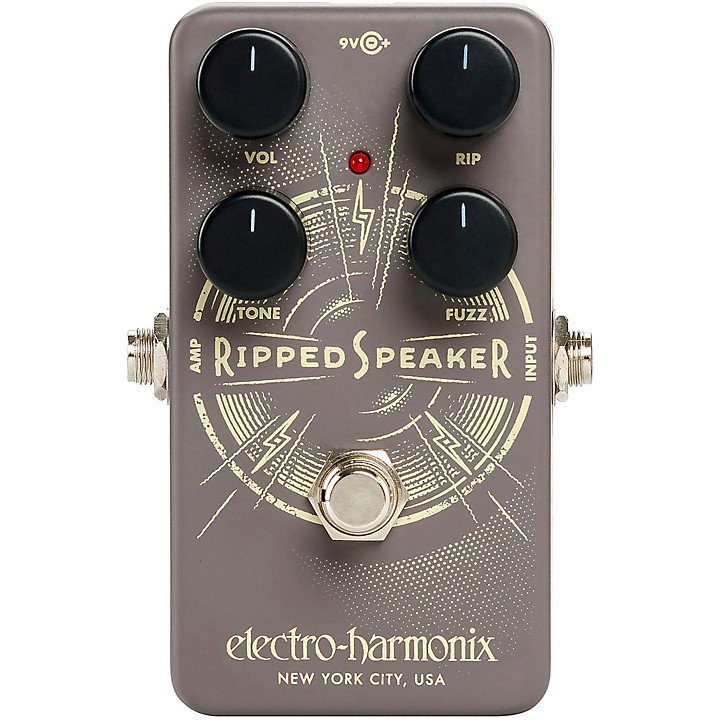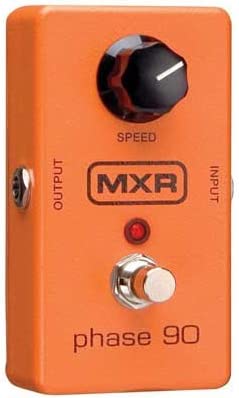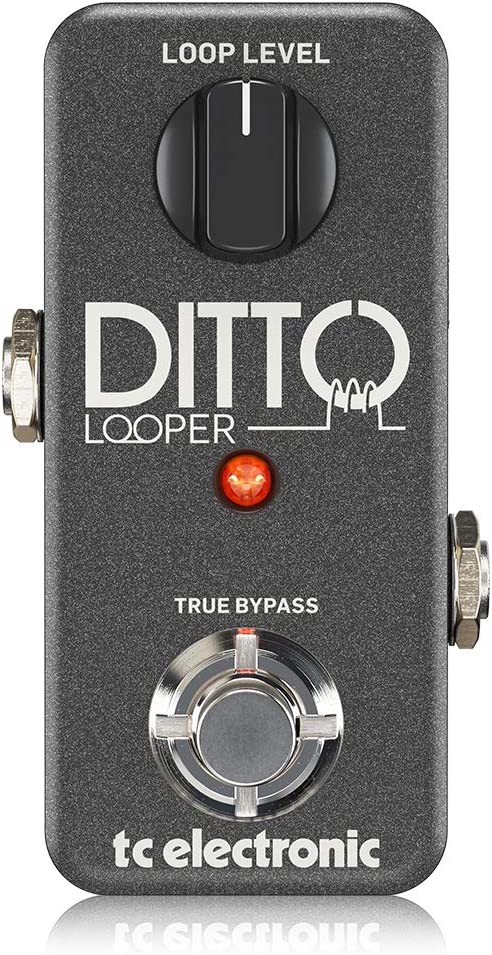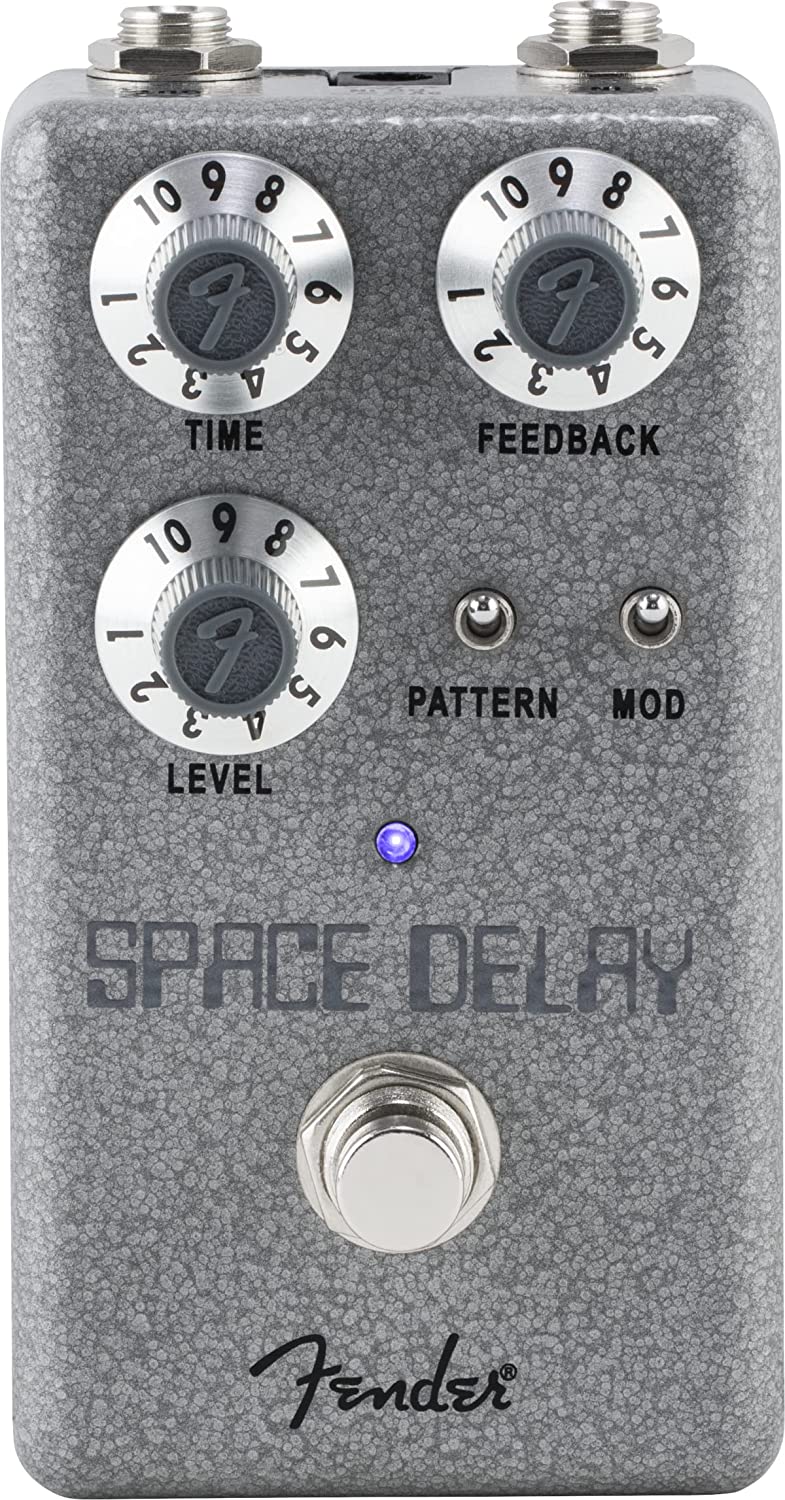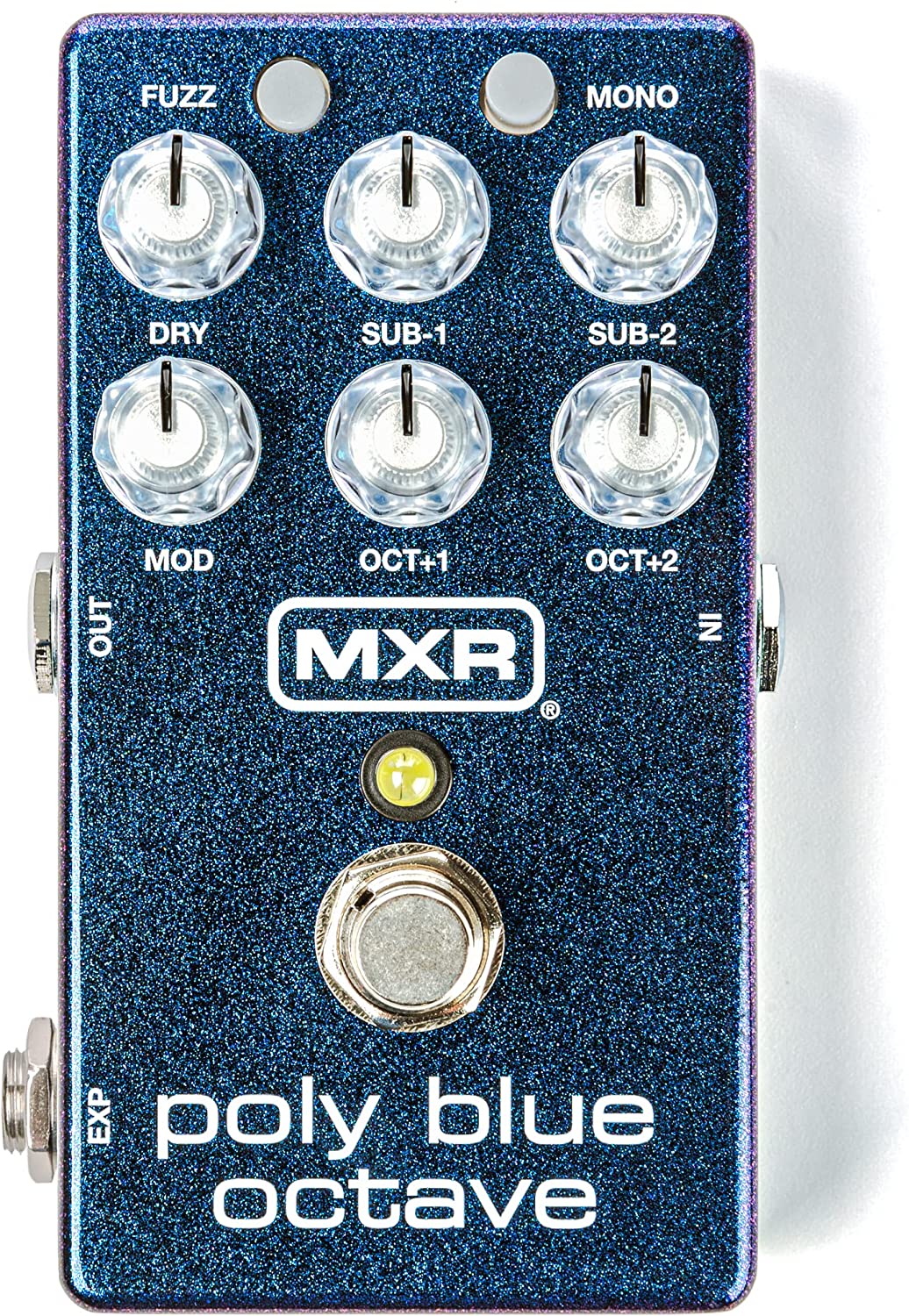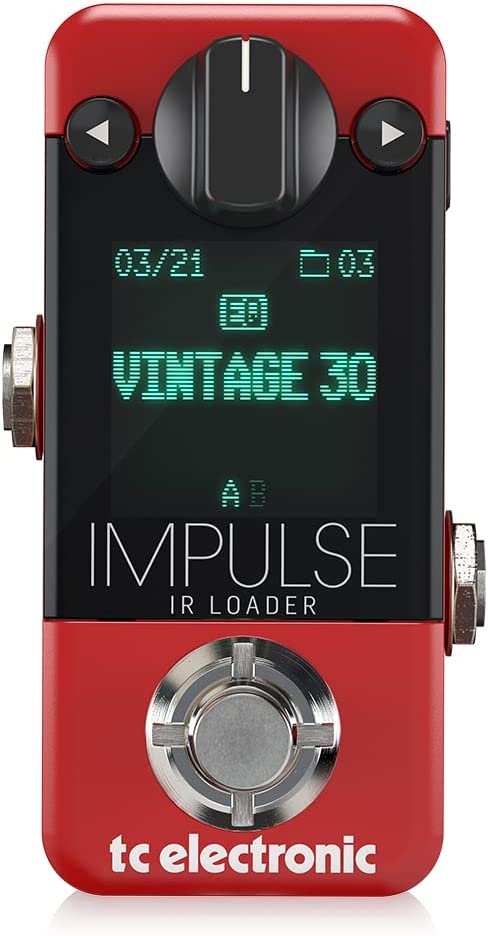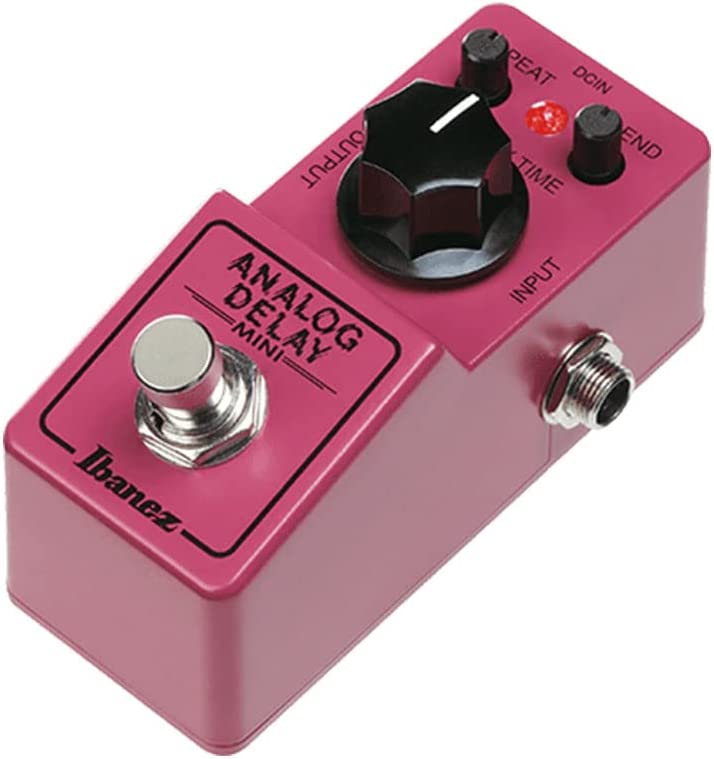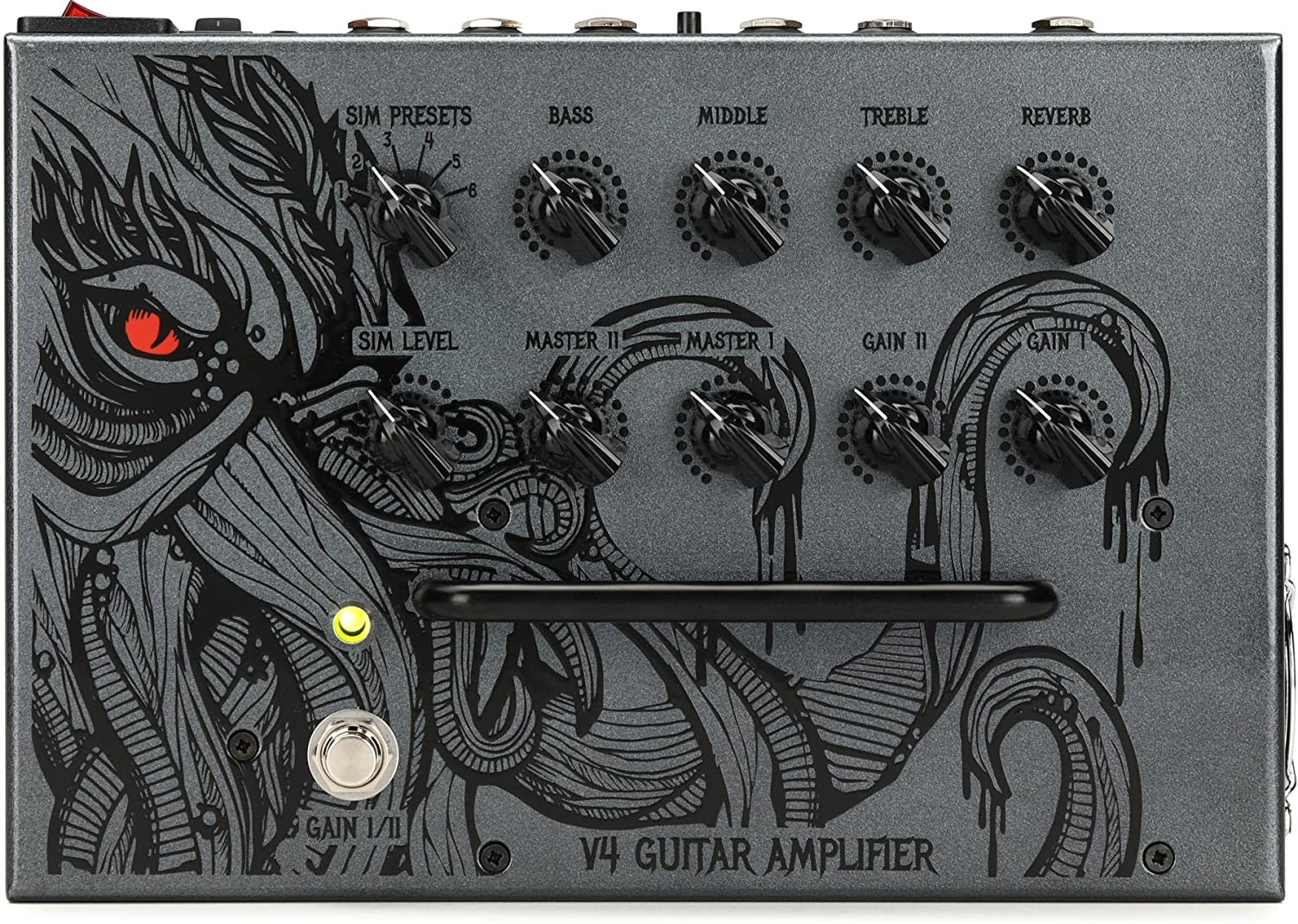Disclosure: We may receive commissions when you click our links and make purchases. Read our full affiliate disclosure here
Do you want to advance your guitar skills? The best way to achieve this is by investing in a high-quality guitar pedal. From overdrive and distortion pedals to loopers and delays, there are plenty of options available for every musician’s needs.
But with so many choices out there, how do you know which pedals are the best for your setup?
What are the Best Guitar Pedals?
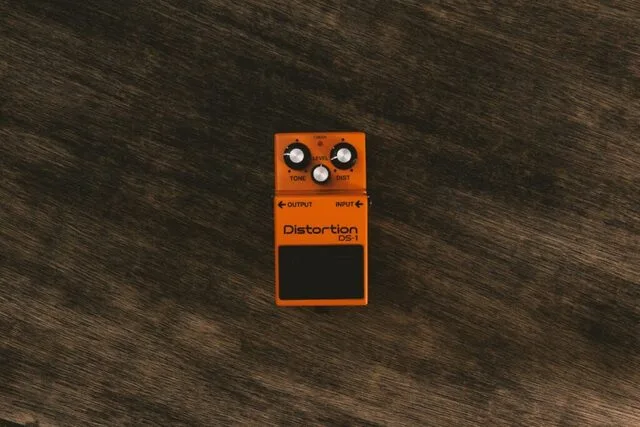
In this guide, we’ll cover everything you need to know, from the types of effects to setting up your pedalboard. We’ll give you all the information you need to find the perfect model. So get ready as we explore what makes these essential pieces of equipment so great.
1. Strymon Timeline Multidimensional Delay Pedal
The Strymon TimeLine Multidimensional Delay Pedal is an incredibly versatile and powerful tool. With extensive MIDI support and a range of tone-shaping knobs, this pedal offers endless possibilities for musicians of all levels. Its studio-class delay algorithms provide nuanced sound, while its three rugged metal footswitches make it easy to switch between presets.
Strymon Timeline Multidimensional Delay Pedal
The LED display provides preset info at a glance, and the BPMtime readout allows you to keep track of your tempo with ease. This guitar pedal also boasts ultra-low noise audio input and output jacks and premium analog front end and output sections for pristine sound every time.
- 200 built-in presets
- Expression pedal control
- A built-in looper
Technical Features
The Strymon TimeLine Multidimensional Delay Pedal has some impressive features that set it apart from other options on the market.
It boasts 30-second stereo looping capabilities, routable pre or post-delay feedback loops, the processing power for enhanced performance, and a 115dB typical signal-to-noise ratio for clear sound reproduction even at high volumes. But that’s not all. It also comes with ultra-low noise 24-bit 96kHz AD & DA converters, so you can capture every nuance in your playing without distortion or interference.
Additionally, its studio-grade audio input and output jacks let you connect it to other devices if needed. Its analog dry path ensures zero latency when recording directly into a computer or digital device without any added coloration or artifacts in the signal chain.
Detailed Review
The Strymon TimeLine Multidimensional Delay Pedal is one of the most comprehensive delay pedals available today. It has a wide range of functions designed specifically for musicians who want maximum flexibility from their effects setup. From subtle echoes that add depth to complex layers of delays that create expansive sonic landscapes – the Strymon does it all!
Its intuitive controls make setting tweaking quick and easy, while its extensive MIDI support allows users to integrate external hardware into their rig if desired.
Plus, it comes with a range of tone-shaping controls, including mix, filter, feedback, time, repeats, grit, and depth.
These parameters give players complete control over their tone, allowing them to create unique sounds tailored perfectly to their own playing style no matter what genre they are performing in!
Verdict
If you’re looking for an incredibly versatile yet simple option, look no further than the Strymon TimeLine Multidimensional Delay Pedal!
With 200 built-in presets plus extensive MIDI support, this unit will have you covered whatever type of music you’re creating – whether it’s rock ‘n roll, blues, jazz, country, funk, soul, or hip hop. Its intuitive controls make setting up sounds fast. It also provides plenty of options should more advanced users wish to delve deeper into crafting unique tones.
So if you’re looking for a top-notch multi-dimensional delay effect, then check out the Strymon Timeline – we guarantee you won’t be disappointed!
This Model is Perfect For
This a great model for musicians who need versatility from their effects setup, players wanting total control over their sound, anyone needing access to external hardware controllers via MIDI integration, and gigging musicians who need reliable performance night after night.
2. Boss Rv-500 Reverb Pedal
The Boss RV-500 Reverb Pedal is a top-of-the-line option that offers studio-level sound with first-in-class 32-bit ADDA, 32-bit floating point processing, and a 96 kHz sampling rate. The AB Simul mode lets you use two reverb patches simultaneously while the selectable carry-over function allows reverb tails to continue even when switching patches or using the effect bypass.
All in all, this is one powerful piece of equipment!
Boss Rv-500 Reverb Pedal
The Boss RV-500 Reverb Pedal exhibits studio-level sound quality thanks to its 32-bit ADDA conversion and 96kHz sampling rate.
- 12 modes and 21 reverb types, all with deep editing parameters
- Equipped with 297 onboard patch memories
- Hands-on controls for a user-friendly experience
Technical Features
It includes 12 modes with 21 different reverb types which can be edited using deep parameter settings. Experience Roland classics such as the SRV 2000 Reverb and the RE 201 Space Echo.
Additionally, 297 onboard patch memories are available, along with hands-on controls for real-time control options. You also get selectable buffered bypass or true bypass operation, making it an incredibly versatile piece of gear.
Lastly, the MIDI IO provides further flexibility, allowing you to integrate your guitar into any digital setup easily without needing additional hardware or software tools.
Detailed Review
The Boss RV 500 is designed for those who want an amazing reverb effect without breaking the bank. This piece of equipment won’t take up too much space in your rig setup – it packs plenty of punch into a small package!
The Boss RV 500 has been designed from the ground up by professionals, so you know you’re getting great value. Its internal DSP provides an independent digital delay modulation rate alongside each individual patch. No matter what type of music you play, this model will offer that great reverb tone!
Furthermore, its intuitive operation makes setting up easy. Simply plug in your instrument via MIDI IO, then adjust the settings. The LCD display will show you the patch name, delay time, and other important information. It’s perfect if you have little experience working with pedals but still want professional results!
Verdict
For musicians looking for amazing, music-changing sounds, look no further than the Boss RV 500 Reverb Pedal – it’s packed full of functions, but it’s a little more affordable compared to other similar products out there today!
The Boss RV’s versatility means that this could be just what your rig needs, whatever genre of music you play. Whether you’re rocking out at live shows or recording in studios, this little beauty won’t let you down.
This Model is Perfect For
Musicians looking for a way to get studio-level sounds from their guitar rigs should consider investing in the Boss RV 500 Reverb Pedal. It’s ideal for both live performance situations and recording sessions. This is all thanks to its intuitive design. Boss ensures every musician gets exactly what they need from their setup quickly and easily.
3. Electro-Harmonix Ripped Speaker
The Electro-Harmonix Ripped Speaker Fuzz Pedal is a versatile and powerful option that offers a range of fuzz tones, from classic to modern.
Plus, the 9V battery included makes it easy to get started right away!
Electro-Harmonix Ripped Speaker
Its compact size will fit on any standard-sized board with ease!
- Bias control
- True bypass switching
- Small and compact
Technical Features
This pedal boasts a RIP knob that acts as a bias control, allowing you to tailor the character of your fuzz sound. The tone control is active, delivering a tilt-shift type EQ. You can adjust the low-end and top-end bite without making it too harsh.
This gives you plenty of options when creating your own unique sound. Additionally, this pedal has true bypass switching, ensuring no signal loss when not in use.
Detailed Review
When using this pedal at a lower setting, you’ll find yourself immersed in lo-fi distortion sounds reminiscent of yesteryear’s rock n roll greats like Led Zeppelin or Jimi Hendrix.
But crank up the fuzz level and watch as your tone transforms into something more modern yet still full of vintage flavor.
And if that wasn’t enough versatility, take advantage of its active tone control, which lets you fine-tune those highs and lows until they’re exactly where you want them!
Verdict
The Electro-Harmonix Ripped Speaker is an incredibly versatile tool that packs tons of punch into its tiny frame, giving guitarists access to everything from old-school tones up to modern-day sounds with ease!
With its adjustable bias controls, active tone shaping capabilities, and reliable true bypass switching, this little gem will become an essential part of anyone’s rig. Take your guitar-playing experience another notch or two (or three!).
This Model is Perfect For
Musicians looking for maximum flexibility from their fuzz pedals will love what this model brings. Whether they’re trying out some classic blues licks or pushing boundaries with new experimental sounds, there isn’t anything else quite like it available today!
4. Mxr M101 Phase 90 Phaser Pedal
The battery-operated or optional AC adapter (sold separately) means you can take it on the road. Provide smooth, watery effects to chords. Muted strumming makes this model an essential part of any guitarist’s arsenal.
Mxr M101 Phase 90 Phaser Pedal
The MXR M101 is a classic and wildly popular phase pedal that has found its way into the rigs of guitarists as wide-ranging as Eddie Van Halen, Dave Grohl, Josh Homme, and Nancy Wilson.
- Simple, single-knob operation
- Wide range of sounds
- Trusted by industry professionals
Technical Features
The MXR M101 Phase 90 Phaser Pedal offers a simple single-knob operation, allowing for total guitar control over your tone. It also works well with guitar, bass, keyboards, and vocals giving you plenty of options when creating your perfect tone.
The speed knob varies from subtle to fast, providing a wide range of tones from shimmers all the way up through watery warbles. So there’s something here for everyone, no matter what style you’re playing.
Detailed Review
This iconic phaser pedal should not be overlooked by any serious musician needing great sounding effects in their rig. Its simple design allows even novice players access right away. However, it still offers enough versatility, so more experienced players won’t feel limited, either!
Its ability to work across multiple instruments gives users plenty of creative freedom when crafting their own unique sounds. So whether they’re looking for something light or full-on, the MXR M101 can do it all!
And thanks to its small size, it fits easily onto most boards without taking up too much space, making life easier if you’re constantly changing pedals between gigs!
Verdict
If you’re looking for a classic phase effect, look no further than the MXR M101 Phase 90. Its ease of use, combined with its impressive array of tones, make this one must-have item in any guitarist’s setup!
Whether you want something mellow or wild, this little box has got everything covered. Don’t miss out on adding some truly unique textures to your music today!
This Model is Perfect For
Musicians who need versatile yet accessible effects at their fingertips will love this model. It’s also great for players who want vintage vibes without breaking the bank and those who need reliable performance night after night.
5. TC Electronic Ditto Looper Pedal
The analog-dry-through feature ensures that your dry signal path remains totally intact, even when the looper is engaged, while true bypass allows for maximum clarity with zero high-end loss when the pedal is off.
Additionally, this ultra-small enclosure fits perfectly on any pedalboard, and its sturdy die-cast metal case makes it ideal for traveling musicians.
All in all, this model has been designed by guitarists specifically for guitarists – making it an absolute must-have if you’re on the hunt for your first pedal!
TC Electronic Ditto Looper Pedal
The TC Electronic Ditto Looper is a highly intuitive looper pedal that provides only essential looping features for total simplicity of use. This makes it perfect for musicians who want to quickly and easily create unique soundscapes without worrying about complex controls.
- 5-minute looper
- Unlimited overdubs
- Undo/redo functions for creative freedom
Technical Features
This incredible piece of equipment comes packed with some impressive functions, including 24-bit uncompressed audio, which ensures ultimate sound quality, fantastic internal memory which retains loops even after you’ve powered down, and a single knob operation that sets the loop playback volume.
Detailed Review
The TC Electronic Ditto Looper offers a super intuitive user experience, making creating amazing soundscapes easy as pie!
Its simple one knob lets you set loop playback volume quickly and easily so you can get right into crafting your masterpiece without wasting time fiddling around with complicated controls.
And, thanks to its 24-bit audio compression capability, you can be sure that whatever sound you create will come out sounding crystal clear every time.
Its robust construction means it’s built to handle whatever rigors touring may throw at it, making it perfect for gigging musicians who need something reliable. You won’t have to worry about breakdowns or malfunctions mid-show!
Verdict
Overall we think the TC Electronic Ditto Looper Pedal is an excellent choice if you’re looking for a simple yet powerful tool.
Its intuitive design makes getting started quick and easy. But it also provides plenty of options for more experienced users to explore further possibilities within their playing style.
And because of its robust build, there’s no need to worry about taking this little beauty out on tour either. So go ahead, rockers – plug in and start jamming away like never before!
This Model is Perfect For
This is a fantastic model for musicians looking for an easy way to add depth and complexity to their playing style but don’t want anything too complicated or intimidating. It’s also great for gigging musicians who need something reliable to take out on tour without fear of malfunctioning during shows.
6. Fender Hammertone Space Delay Pedal
The modulation switch adds a swirling, choral effect on the repeats that can be adjusted with internal trim pots, while the “F” logo knobs are easy to read and stand out on stage.
Plus, it boasts true bypass switching for easy setup.
Fender Hammertone Space Delay Pedal
The Fender Hammertone Space Delay is a great choice for guitarists who want to add some vintage-style delay effects to their sound. In addition, this pedal gives you plenty of options for creating unique sounds.
- Three distinct repeat patterns
- Up to 950ms of delay time
- Housed in a rugged aluminum enclosure
Technical Features
This model offers an array of functions designed specifically for guitarists looking to expand their sonic palette.
It emulates a tape delay effect with pattern and mod switches and top mount input/output jacks. There is also true-bypass switching with analog dry-through technology to keep your tone pure while using the effect. It’s powered by a 9-volt center negative AC adaptor (not included).
This pedal also comes equipped with three separate delay patterns that emulate classic tape echo units.
Finally, its “F” logo controls are both easy to read and grip, making them ideal when you’re performing live onstage or in the studio.
Detailed Review
The Fender Hammertone Space Delay provides guitarists with all they need to add vintage-style delays into their soundscapes without having too many bells and whistles getting in the way of creativity or performance.
With its three distinct repeat patterns and an additional modulation switch that offers further control over your tone, this pedal really does have something special going on under the hood!
And thanks to its top mount input and output jacks coupled alongside true bypass switching, setting up is quick and simple. You can to playing faster than ever before!
Verdict
In conclusion – if you’re after a reliable yet versatile tape delay effect, look no further than the Fender Hammertone Space Delay! Its ease of use plus incredible tonal capabilities makes it one heckuva piece of kit – perfect for any guitarist looking to take their performance up another level!
This Model is Perfect For
Guitarists who desire an authentic-sounding vintage-style tape echo effect but don’t want anything overly complicated will find exactly what they need with this little box of tricks from Fender!
Whether you’re playing live shows or recording in studio environments, this pedal will provide just enough tweakability without overwhelming those unfamiliar with complex signal processing chains. It’ll allow even novice players the ability to access previously unattainable tones at an affordable price point.
7. MXR Poly Blue Octave Pedal
The MXR Poly Blue Octave Pedal is a great option for guitarists looking to add some unique and creative sounds to their playing. You can create lush and complex tones with ease.
MXR Poly Blue Octave Pedal
The Poly Blue Octave Pedal comes with four separate octave controls that you can use together or independently – 1 up, 2 up, 1 down, and 2 down – allowing for a wide range of tonal possibilities.
- Four separate octave controls that can run simultaneously
- Dry level control
- Built-in fuzz for an extra edge of versatility
Technical Features
The dry level setting lets you blend your original signal with pitch-shifted tones, so they don’t overpower each other.
The polyphonic design means chords will sound as great as single notes. At the same time, the mono switch offers a gritty and vintage analog-style sound reminiscent of classic modulations from decades past.
There’s also a dual modulation circuit that mimics Leslie-style sounds in poly mode while offering phase 90-type effects in mono mode.
Finally, the EXP jack lets you connect an outboard expression pedal if needed, too!
Detailed Review
This versatile pedal has plenty going on under its hood – starting off with its four independent octave controls. These allow players to craft complex sounds and explore new harmonic ideas without having to worry about getting lost amongst multiple pedals on their board. This makes it perfect for those who like experimenting but don’t want too much clutter around them when performing live!
Its dry level setting is also very useful – it lets users adjust how much of their original signal is blended into their tone, allowing them to keep things natural even when using extreme amounts of effect processing at once!
Furthermore, its built-in fuzz provides grit and texture while keeping everything tight and punchy throughout any performance. Plus, there’s always room for experimentation. Get depth and complexity depending on whether one chooses mono or poly modes, respectively.
Verdict
Overall we think this guitar pedal is perfect for anyone looking for creative ways to expand upon traditional guitar sounds without taking up too much space on their board or spending hours tweaking the settings!
This Model is Perfect For
This guitar pedal is ideal for musicians who require a straightforward method to alter their sound rapidly while still having access to premium audio samples. Its intuitive layout makes it easy enough that even beginners should have no problem navigating it quickly and efficiently. They’ll still be able to manipulate the pedal sufficiently enough to get whatever kind results they’re after within minutes rather than hours.
8. TC Electronic Impulse IR Loader Pedal
The TC Electronic Impulse IR Loader Pedal is a great choice for guitarists who want to get the most out of their sound. With its drag-and-drop USB capabilities, it’s easy to load up your favorite IRs (Impulse Responses) with just a few clicks.
The pedal also comes pre-loaded with 25 different IRs, 12 of which are official Celestion digital ones, 8 TC Electronic Pedal Platform IRs, and Acoustic Guitar IRs in slots 21-25. This makes it incredibly convenient for those looking to quickly switch between tones without worrying about finding the right one each time. It’ll also give life to a dull Piezo.
TC Electronic Impulse IR Loader Pedal
The TC Electronic Impulse IR Loader offers an impressive range of features that make it stand out from other models.
- 25 different IRs
- Collaboration with Celestion
- Drag-and-drop USB capabilities
Technical Features
Its footswitch can operate in two modes – AB mode allows you to toggle between two pre-defined IRs, while its single knob adjusts the output level easily and accurately.
Additionally, this pedal takes on impulse responses (IR) of up to 200ms in length, so you can really dial in your desired tone precisely and effectively.
Lastly, there’s a Global Compensation EQ built into the pedal, which helps shape your sound even further if needed!
Detailed Review
This pedal is very easy to use due to its intuitive design and layout, making loading new sounds quick and painless whenever you need something fresh or unique sounding!
The included selection of 25 different presets are all excellent, too, providing plenty of options when creating your own signature tones.
Furthermore, thanks to its dual operating modes, switching between two distinct settings is made simpler than ever before, allowing more creative freedom during live performances and studio sessions alike!
Verdict
Overall, the TC Electronic Impulse IR Loader is an excellent choice for any guitarist looking for convenience when changing up their music quickly but still wanting top-notch audio at all times too!
Thanks to its drag-and-drop capabilities along with its Global Compensation EQ, you’ll be able to create truly unique sounds that fit perfectly within any genre or style imaginable!
This Model is Perfect For
This guitar pedal is ideal for musicians who require an expeditious method of altering their sound while still having access to top-notch audio samples. It’s also great for guitarists in need of dependable performance both on and off the stage and songwriters looking to experiment with a variety of effects combinations.
9. Ibanez Analog Delay Mini Pedal
Its two smaller controls make it easy to adjust the repeat and blend, while its larger knob allows you to dial in the exact amount of delay time you need.
The true bypass switching ensures that your signal path remains as short and clean as possible without compromising on tone, so your sound stays pure, pleasing any guitarist’s ears!
Ibanez Analog Delay Mini Pedal
The Ibanez Analog Delay Mini is a great choice for guitarists looking to add warmth and classic delay tones to their music. This model is incredibly compact, making it perfect for those with limited space on their pedalboard.
- Incredibly compact
- True bypass switching
- 100% analog circuitry produces warm tones
Technical Features:
The Ibanez Analog Delay Mini comes with repeat, delay time and blend controls, giving you full power over your music. The range of delay time is 20ms-600ms while the required current draw is 23mA@9V when powered by an external DC 9-volt AC adapter (center negative).
This model was made in Japan and offers exceptional structure at an affordable price.
Detailed Review
This mini pedal from Ibanez packs a lot of punch into such a small package! Despite its size, this little guy delivers when it comes to producing warm analog delays – something that many guitarists look for in pedals like these.
With just three controls – one large one for adjusting the delay time plus two smaller ones for controlling repeat rate and blend levels – this mini-model makes setting up your desired sound quick and easy.
And thanks to its true bypass switching technology, you don’t have to worry about any unwanted noise or interference creeping in, either!
Verdict
If you’re looking for a reliable yet affordable way to add some analog delays to your setup, look no further than the Ibanez Analog Delay Mini!
Thanks to its small footprint but big sound capabilities, this little gem will be right at home on even the most crowded of boards without taking up too much space or breaking the bank either!
This Model is Perfect For
Musicians who want classic analog delays but don’t have enough room on their board will love this model. It’s also great for players after more control over their repeats, all at an affordable price.
10. Victory V4 the Kraken Amplifier Pedal
The Victory V4 The Kraken is a great choice for guitarists looking to take their performance to the next level. With its award-winning design and hard-rocking sound, this model will make any guitarist stand out from the crowd.
Victory V4 the Kraken Amplifier Pedal
The Victory V4 The Kraken Amp comes equipped with an EC900 valve running at high plate voltage along with 3 CV4014 valves for added power.
- All-valve signal path
- Two channels with gain 1 and gain 2 settings
- Remote switching capabilities
- Three-band EQ controls
Technical Features
It has two channels that offer different gain sounds – gain 1 is slightly looser, while gain 2 offers a tighter bass response with more midrange.
There’s also a bright switch that optimizes the preamp for whatever you’re plugging into it, and three-band EQ controls for powerful bass, middle, and treble adjustments.
Additionally, this EQ pedal can be used both live and in the studio, making it perfect for any musician’s setup.
Detailed Review
When it comes to sound, the Victory V4 Amp really shines through in comparison to other pedals on the market today.
Its all-valve signal path ensures that your tones are always full of life, while its dual channel options give you plenty of room to experiment with different gain levels, depending on what genre you’re playing or recording – opt for high gain, or experiment with lower gain.
On top of that, there’s also a bright switch that helps optimize your tone when plugged into various amps or interfaces. That’s right – you never have to worry about losing clarity in your mix, no matter where you play or record from!
Verdict
If you’re looking for an amplifier pedal that packs some serious punch, look no further than the Victory V4 The Kraken Amp Pedal!
Its all-valve signal path provides some truly amazing tones, while its dual-channel design gives players plenty of flexibility when crafting your own unique soundscapes. Plus, it’s built like a tank, meaning it can handle whatever rigors come its way!
Due to its size, transporting this amp around might not be ideal. However, we highly recommend giving it a try if you’re looking for something special!
This Model is Perfect For
Professional musicians who want maximum versatility without sacrificing tonality should definitely check out this amp. Whether they need something small enough to fit in their gig bag or a heavy-duty model for those long hours in the rehearsal studio, this amp has them covered!
Buyer’s Guide and FAQs
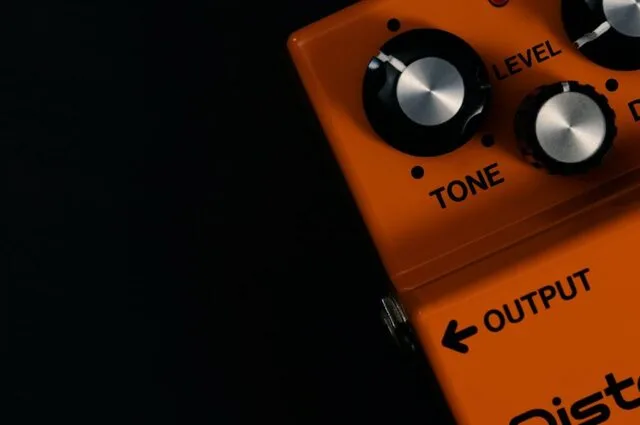
With so many guitar pedals offering so many different features, navigating the pedal landscape might feel overwhelming. But don’t worry – we’ll give you the lowdown on everything you need to know, from picking the perfect model for your genre to knowing what to avoid.
Read on to find out more.
Types of Guitar Pedals
Guitar pedals are essential tools for creating unique and interesting sounds. They come in a variety of shapes, sizes, and types. Different pedals all serve different purposes. So whether you’re looking to add some extra punch to your playing or create lush sonic landscapes, there’s something out there that can help.
From the multitude of pedals available, here’s a brief look at some of the most commonly used types for enhancing your guitar.
Distortion Pedals
Distortion pedals provide players with overdriven or distorted tones by clipping the signal waveform at its peak level. This effect adds warmth and grit to clean guitar tones while allowing notes to remain clear and articulate.
Popular distortion models include the Boss DS-1 Distortion Pedal and MXR M75 Super Badass Distortion Pedal.
Overdrive Pedals
Overdrive pedals are similar to distortion but have less gain in their output signal than distortion pedals do. This creates a more natural-sounding drive when used in conjunction with other effects such as delay or reverb.
The Ibanez Tube Screamer TS808 Overdrive Pedal is one of the most popular models due to the warm yet crunchy tone it produces when engaged with higher settings.
Delay and Reverb Pedals
Delay effects replicate an instrument’s original sound after a certain period of time has elapsed, usually ranging from 25 milliseconds to several seconds, depending on the type of pedal.
Reverb simulates how sound behaves in different spaces, such as churches or halls. The Strymon Big Sky Reverberator offers a wide range of realistic reverb sounds, from shimmer to cloud reverb. The more reverb sounds, the more you can manipulate your music.
Chorus/Flanger/Phaser Effects
These three effects work together by manipulating frequencies within a specific range. Chorus thickens your tone by adding multiple copies that are slightly detuned from each other. Flangers will sweep through those same frequencies, giving them a jet engine-type swoosh.
Phaser pedals use frequency notches, which make them ideal for psychedelic rock styles since they’ll give your playing an almost “wah-wah” type feel. Some great examples include Electro Harmonix Small Stone Nano which combines all these three effects into one tiny package. You can also check out the MXR EVH90 Phase 90 if you’re looking for something more expensive that still delivers great results.
Guitar pedals exist in a plethora of forms and sizes, each bringing its own unique sonic character. Deciding which pedal is the best fit for your style can be a challenge given the multitude of options.
Volume Pedals
Volume pedals allow for total control over the volume of your guitar. These versatile options work with any genre you play.
Important Takeaway: Guitar pedals can open up a whole new world of sounds and textures. From distortion to overdrive, delay, and reverb to chorus / flanger / phaser effects, there’s something for everyone. With so many options available, it’s no wonder why guitarists are spoilt for choice when it comes to finding their ideal sound.
The Benefits of Using Guitar Pedals
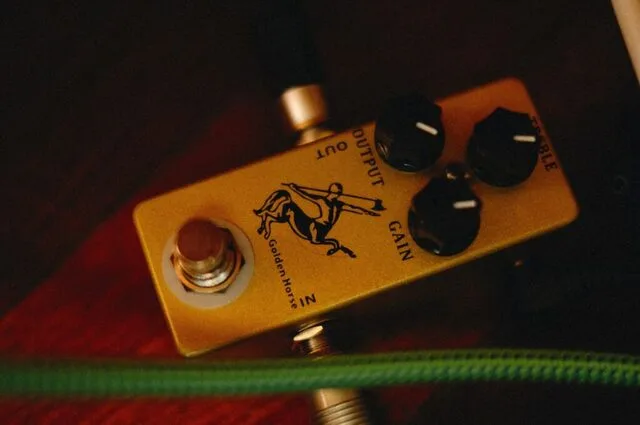
Guitar pedals can help musicians explore a world of creative possibilities. From classic rock to modern metal, guitarists have used effects pedals to craft unique tones for decades. Grasping the fundamentals of these gadgets can assist you in optimizing your setup, no matter if you’re a novice or a seasoned player.
By using guitar pedals, it’s possible to shape your sound in a way that amplifiers alone cannot replicate, allowing you to explore a wide range of sonic possibilities. It’s possible to create lush textures and dynamic sonic landscapes that add depth and character to your playing. From adding subtle chorus or delay effects to creating wild fuzz-laden walls of noise, there are endless possibilities when it comes to crafting your signature tone.
Effects pedals also provide flexibility when it comes to live performances or recording sessions in the studio. With multiple effects at your disposal, you can quickly switch between different sounds without needing multiple amps or complicated setups – all while keeping one foot firmly planted on stage. This allows players to experiment with different tonal options on the fly without disrupting their setlist flow or taking too much time away from their audience.
Another Great Advantage is Portability
Many popular models are small enough to fit into a gig bag along with other essential gear like cables and picks. They are ideal for touring musicians who need quick access during shows but don’t want bulky equipment weighing them down on long trips from venue to venue.
There’s no denying the sheer fun factor associated with experimenting with new sounds; whether you’re jamming out at home or onstage in front of thousands, discovering fresh ideas through trial and error never gets old. It may take some practice and patience before finding exactly what works best for each individual player, but once those magic settings are found, watch out.
Guitar pedals can unlock a realm of audio potential, allowing musicians to tailor their tone and craft special sonic atmospheres. To ensure you get the most out of your playing experience, it’s essential to select a pedal that meets your individual requirements.
Important Takeaway: Guitar pedals allow players to shape their sound in a way that standard amplifiers simply can’t achieve, enabling them to craft unique sonic textures for live and studio applications easily. They provide flexibility for live performance and recording sessions, portability so they can fit into a gig bag, and endless possibilities for creating unique tones.
Choosing the Right Pedal
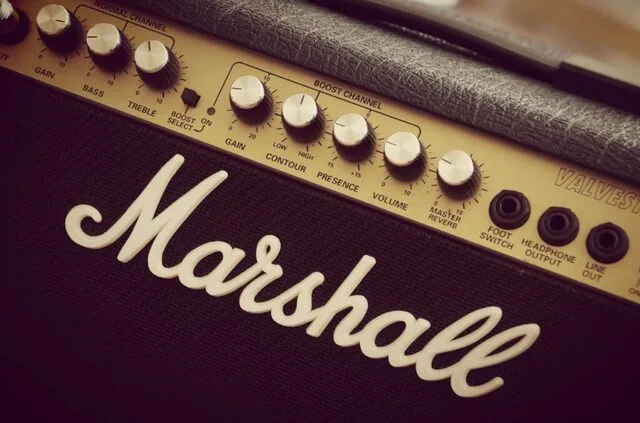
When it comes to guitar pedals, there’s no one-size-fits-all solution. No two guitar pedals are the same. It’s super important to consider your needs and budget when selecting your first effects pedal.
Here are a few tips to help you make the best decision.
Know Your Gear
Before you start shopping, it’s important that you understand what type of gear you have and how it interacts with each other. For example, if your amp has built-in effects or your guitar has active pickups, those will affect which type of pedal works best with your setup.
Understand Your Tone
Think about what you want to achieve before choosing a model. Do you want an overdrive effect? A distortion effect? Or maybe something more subtle, like a reverb or chorus? Knowing exactly what kind of tone you’re after can help narrow down your choices significantly.
Research Pedals and Prices
Once you know what type of effect(s) you’re looking for, research models within that category. Look into controls, battery life/power requirements, etc., as well as price ranges for each model. This way, when the time comes to buy one, you won’t be overwhelmed by all the options available.
Consider Quality vs. Cost:
It’s always tempting to go for cheaper models but keep in mind that quality usually costs money, especially when it comes to effects pedals. Try not to overlook higher-priced models because they may actually provide better value in terms of sound and durability compared to their cheaper counterparts (this is especially true for boutique brands).
For those seeking to economize, buying pre-owned gear is an excellent way to acquire amazing items at a reduced price. However, it’s important to ensure any effects pedals you’re considering have been properly tested beforehand. Try out the unit yourself or read reviews from reputable sources before purchasing.
In the end, selecting which pedal suits you boils down to your goals and budget.
Important Takeaway: When choosing the correct pedal for your setup, there’s no universal answer. Do some research on various models within a given category. Consider the cost, and don’t forget to try out any pedals you’re considering before committing to a purchase – it pays off in the long run.
Setting Up Your Pedalboard
Setting up a pedalboard can be intimidating at first, but with the right tools and knowledge, it’s easy to get your rig sounding great. The key is understanding how all the pieces fit together, so let’s break down what you need to know.
It’s important to have the correct power supply for your effects pedals. Most modern pedals use 9V DC power supplies, though some require higher or lower voltage levels. Make sure you check each pedal’s requirements before plugging them in. Cables for linking your pedals together are necessary – sizes and lengths vary depending on your needs.
Once everything’s connected, it’s time to decide the order of your effects pedals on the board. Yes – putting your pedals in a particular order makes all the difference. Generally speaking, putting more subtle effects like reverb or delay near the beginning of your chain will give those sounds more room to breathe.
For example, if you’re using a distortion pedal followed by an overdrive effect, then it might be better if they were placed next to one another instead of being separated by other effects like chorus or flanger. Similarly, placing modulation effects such as phasers and tremolos toward the end of your chain can help create interesting textures that won’t get lost in other sounds.
When positioning multiple pedals onto a single board, there are several factors you must take into account – size being one of them. Effects pedals come in all shapes and sizes, so make sure there’s enough space between them for comfortable access while playing live shows (or recording). It may also be worth investing in protective coverings for certain parts, particularly those made from metal which could rust due to moisture build-up during gigs and tours.
Don’t forget about noise reduction. Many guitarists opt for noise suppressors either at the start or end of their signal chains, as this helps reduce any unwanted buzzing/humming caused by interference from other equipment nearby. This ensures that every note played comes through crystal clear without any distractions getting in its way.
Important Takeaway: Constructing a pedalboard can be challenging, yet with the proper power source and cables, you’ll be ready to rock. Make sure all your pedals have enough room on the board, and don’t forget about noise suppression for that crystal-clear sound.
Tips for Getting the Most Out of Your Effects Pedals
When it comes to getting the most out of your guitar pedals, experimentation is key. To get the best results, it’s important to understand how to configure and use your pedals properly.
Here are some tips for getting the most out of your effects pedals.
1. Tweak controls and switches, adjust levels, or blend two effects together to uncover unique sounds. Try turning switches on and off, adjusting levels, or even combining two effects together to find new sounds you like. Mix it up and delve into the capabilities of your model to discover fresh tones.
2. Combining various effects allows you to create unique textures and depth that would not have been possible with only one effect. For example, adding reverb after distortion can give a thick yet smooth tone that would be impossible without both effects pedals working in tandem. Additionally, running delay into chorus or flanger into phaser creates an entirely new level of sonic possibilities that may have not been achievable before.
3. When using modulation-based effects such as chorus or vibrato, it’s best practice to place them at the end of your signal chain (after any distortions). This allows these subtle nuances in pitch/timbre manipulation from modulation-type effects to stand out better against already distorted tones rather than being washed away by overdrive/distortion beforehand.
4. Many guitars come equipped with volume controls which allow you further adjust the dynamics between clean and distorted signals when playing live shows. This feature is often overlooked but incredibly useful when dialing in just the right amount of crunch and sustain during solos.
5. If possible, try placing buffered bypass type pedals first within the signal chain – this ensures they’re able to maintain their high fidelity while still providing maximum tonal clarity for the other effect boxes down the line.
6. Finally, don’t forget about rearranging the order of certain effect boxes within your signal chain. Swapping around the positions of various stompboxes can completely change the overall sound palette available, allowing for greater creativity and exploration opportunities.
By following these strategies, you can guarantee that your guitar pedals are giving the desired effects. Additionally, learning about popular brands and models of pedals will help ensure that you can choose a model best suited to your playing style.
Important Takeaway: To unlock the full potential of your pedals, try experimenting with different combinations. You can create unique sounds by combining different effects and adjusting switches. Lastly, don’t forget about rearranging effect boxes within your board. Sometimes a simple swap around will open up new sonic possibilities.
FAQs in Relation to the Best Guitar Pedals
What pedal should every guitarist have?
Every guitarist should have a delay pedal in their setup. Delay pedals create an echo effect that you can use to add texture to your playing. They also allow you to play complex rhythm patterns and repeat single notes or chords for interesting lead lines.
Additionally, you can use them to layer multiple sounds together and provide extra depth when recording in the studio. No single model can suit every need. It’s essential to find the appropriate one for your music and preferences.
What is the most useful guitar pedal?
The most useful guitar pedal depends on the individual musician and their playing style. Generally, a compression pedal/sustainer is considered one of the most versatile pedals for any guitarist, as it can help even out dynamics while adding sustain and volume to solos.
Other popular options include delay/reverb pedals, which add depth and atmosphere to your sound, overdrive or distortion pedals that give you more gain, chorus or phaser effects for added texture, and multi-effect units that offer a variety of sounds in one box. Ultimately, choosing the right one comes down to experimentation – so don’t be afraid to try something new.
What pedals did Pink Floyd use?
Pink Floyd used a variety of pedals in their music, including wah-wah, fuzz tone, and distortion. They also used delay units such as the Binson Echorec and the Roland Space Echo.
Additionally, they employed various chorus, phaser, and flanger effects. If you want to sound like them, try models like the MXR, Electro Harmonix Big Muff Pi Fuzz, and Ibanez Tube Screamer TS808 Overdrive Pedal.
Pink Floyd’s use of these effects helped create their unique sound that has become iconic over time.
What effect pedals did Kurt Cobain use?
Kurt Cobain was known for his unique guitar sound. He achieved this by using a variety of effects pedals. He used the Electro-Harmonix Small Clone Chorus, Boss DS-1 Distortion, and MXR Dyna Comp Compressor.
He also utilized various other devices to find that perfect sound.
Conclusion
Whether you’re playing acoustic or rocking out on the electric guitar, the best guitar pedal can make a huge difference in your performance. The right model will help you elevate your playing and make unique sounds that will mesmerize listeners.
When choosing the best pedals, consider the type of effect you desire, your budget, the size and weight, and how well it integrates with other effects on your board. Proper setup and maintenance are also important to get maximum use out of these powerful tools. Explore All Axess for the latest reviews and guides on musical instruments, including the best guitar pedals. Get informed to make an educated decision when selecting gear for your next performance.


